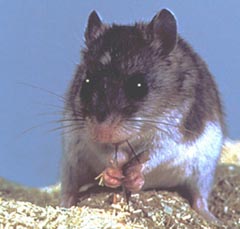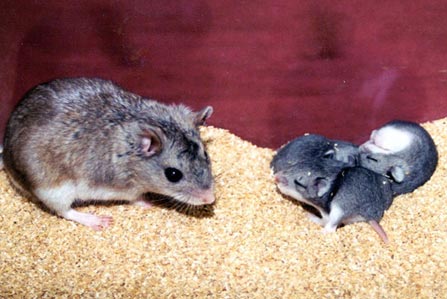In Search of the Mouse That Roars
Air Date: Week of October 3, 2003
There are stories, some even claim sightings, of the source of a sound so rare that recordings of it in the wild are near impossible. Producer Jeff Rice takes on the challenge, and hikes into the desert southwest on a quest for the howling mouse.
Transcript
CURWOOD: Think of the word “quest” and you might think of such lofty aims as truth, justice, the Holy Grail. Well, producer Jeff Rice recently went on a quest not long ago. A quest for a sound. And, as you'll hear in this piece, a rather special sound at that.
[NIGHT SOUNDS, TOAD CALLS, CRICKETS]
RICE: Once near the Henry Mountains in Utah, I thought I might have heard one. But it's like trying to take a picture of a ghost. And all that came through on my microphone was the steady croaking of toads.
[TOADS]
RICE: I wonder if I'll know it when I hear it.
[ROLLING THUNDER]
RICE: I'm in the Idaho desert on the edge of a giant sea of sagebrush. The pioneers here complained of monotony, blowing wind – and strange creatures.
[THUNDER]
RICE: There was the jackelope, of course. And the four-toed sasquatch. But I'm here for something even stranger. Because it's real.
[SOUND OF CAR ON HIGHWAY]
RICE: To steel my nerves, I stop off for a drink along the highway. I'm in Atomic City, a town of about 25 people, 50 horses, and 3 bars.
[PEOPLE TALKING]
RICE: I'm on a quest…which some people here seem to think is pretty funny.
[LAUGHTER]
RICE: I'll be setting up camp on the edge of town so I can hike through the sagebrush at night with my microphone. I'm excited because there have been some sightings. I've been told a few of them have been trapped near here.
MALE: I would dare say that's a myth.
RICE: Outside in the desert, it's pitch dark. There are little red eyes peering from the dry grass. They could be almost anything. But I know that somewhere in the sagebrush a Northern Grasshopper mouse is howling.
MALE: It's a Northern Grasshopper mouse [LAUGHTER].
[SOUND OF CRICKETS, WALKING THROUGH GRASS]
RICE: This mouse is about the size of a small hamster. You can find it in the sage prairie in places like Idaho, Utah, and Oregon. And on into Texas and even as far north as Minnesota. It's one of the few carniverous mice, thus its name. It likes to eat grasshoppers and scorpions and even other mice. But what makes this mouse interesting--to me, at least --is its call. According to reports by biologists, it waits for the dark of night, gets up on its hind legs, throws its head back and:
MALE: Howls like a wolf [LAUGHTER].
[MEN HOWLING LIKE WOLVES, CRICKETS CHIRPING]
RICE: It's tempting to laugh, but it's true. One of the first biologists to make note of this behavior was Vernon Bailey. In 1931 he wrote that its howl was “as smooth and prolonged as the hunting call of the timber wolf.” And that it “is made with raised nose and open mouth in perfect wolf form.” Today, biologist Robert Sikes studies Grasshopper mice at the University of Arkansas.
SIKES: The mouse will kind of sit back on its hindquarters, point its nose toward the sky and howl. Another posture I've seen is where the mouse actually stands up on its hind legs, forepaws completely off the ground, standing up almost vertically and, again, points the nose towards the sky and howls. It's very much like a canid howling at the moon.
RICE: Now, I've heard a few campfire stories in my life, but this is one I had to check out for myself.
FINLEY: Oh it's definitely real.
RICE: That's Tommy Finley. He's a graduate student in Dr. Sikes' lab.
FINLEY: I don't think there's anything supernatural or anything like that. I think it's perfectly natural for this animal.
 A Northern Grasshopper mouse eats a cricket.(Courtesy of R.S. Sikes, University of Arkansas at Little Rock) A Northern Grasshopper mouse eats a cricket.(Courtesy of R.S. Sikes, University of Arkansas at Little Rock) |
RICE: Sikes and Finley have been making recordings of grasshopper mouse howls in the lab, and were kind enough to give me some. Recordings are extremely rare. According to all the experts I spoke with, none of them knew of a recording of the howl that had been made in the wild. There's a pretty good reason for that. Here's what the recording from the lab sounds like.
[FAINT HIGH PITCH BUZZ] RICE: Did you hear that? Maybe not. Here's the thing. As mighty as the howl is, it's really, really high pitched. And that's a problem for our puny human hearing. We hear frequencies as high as 20,000 hertz. And that's if you have just about perfect hearing. The Grasshopper mouse howl gets up to almost 14,000 hertz. Hear it on your car radio? Not likely. It works better if I lower the pitch by slowing it down. [SLOWED DOWN HOWL; LOUDER THAN BEFORE] RICE: There you have it. The howling mouse of the prairie. [SLOWED DOWN HOWL] RICE: So here I am, out in the desert trying to capture it on tape. [CRICKETS, OWL SCREECHING] RICE: Nearby, what look like two owls fight in the darkness. [OWL SCREECH] RICE: But the Grasshopper mouse remains elusive. If I want to be assured of hearing one in person, I need to go a little farther afield. [SQUEAKY DOOR] SIKES: Ok, we're in the Basic Animal Services Unit at the University of Arkansas at Little Rock. We are housing currently just slightly over 600 of these Grasshopper mice. These are Northern Grasshopper mice. RICES: At exactly 7:30 every night here, the lights go out in Dr. Sikes' grasshopper mouse lab. And every night the howls begin. [FAINT HIGH-PITCHED HOWL] RICE: These mice are nocturnal, and are most likely to howl in the darkness. So, here we are, surrounded by hundreds of mice in cages, in the pitch black. I can't see my microphone in front of my face. At this point, I think what the hell am I doing here? But suddenly, Dr. Sikes becomes very excited. SIKES: Right now, they are vocalizing like crazy in this room. We simply can't hear it. We hear the tiniest tip of the iceberg of what's actually going on. You can hear the mice moving around a lot here. RICE: Mostly, what I'm hearing is the chewing of food pellets. And I admit that trying to listen to sounds that other people don't hear is the definition of insanity. Especially when it comes to howling mice. Just ask graduate student Tommy Finley. FINLEY: You’re talking about people thinking you're crazy, really. They think I'm crazy spending my Friday and Saturday nights up here listening to Grasshopper mice howl all night. [LAUGHTER] RICE: But then, every once in a while, out of the darkness, there is a prolonged squeak--like a rusty hinge.
[CAGES BANGING] RICE: Ooh, he howled right there. FINLEY: You see? RICE: Yea. [FAINT HIGH PITCHED HOWL] SIKES: In fact, one mouse may be starting a call, a long loud call. And then immediately one or more mice will join in. RICE: A pack of mice howl wolflike in the dark. It is all that I had imagined. The meaning of the howl seems pretty apparent. Scientists think that it is territorial, in much the same way that a wolf's howl is territorial. Grasshopper mice have large ranges for their small size. Up to five acres, and the high-pitched howl will carry over a large distance. Dr. Sikes says the fact that a mouse howls and even looks like a wolf when it's doing it makes perfect sense. SIKES: That would be the posture that I would take. You want to channel that emission where there's going to be the least interference, i.e. up. Not down into the ground. Not into the vegetation. But get it up. So I think that posture is probably correct. Also, if you watch singers, typically they don't sing when sitting down. RICE: It's comforting to find that the same laws of nature that govern wolves, also govern mice – and men. [NARRATOR HOWLING IN BACKGROUND] RICE: For Living on Earth, I'm Jeff Rice in the Idaho desert. [NARRATOR HOWLS] [MUSIC: Elliot Smith “Bye” FIGURE EIGHT (Dreamworks – 2000)] CURWOOD: Our story on Grasshopper mice is part of the “Hearing Voices” series that is funded, in part, by the Corporation for Public Broadcasting. [MUSIC: Elliot Smith “Bye” FIGURE EIGHT (Dreamworks – 2000)] Listen to a sample of the mouse's howling at normal pitch: Links
|

 A Northern Grasshopper mouse and her litter.
A Northern Grasshopper mouse and her litter.



